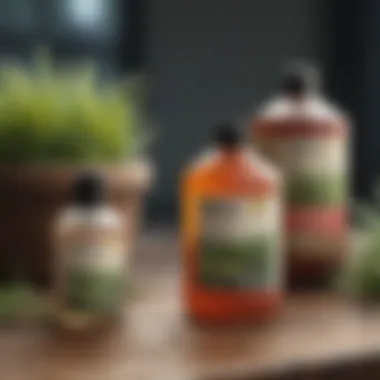Pet-Safe Weed and Grass Killers: A Complete Guide


Intro
When it comes to maintaining a garden, choosing the right weed and grass killer is crucial, especially for pet owners. The selection of herbicides must balance efficacy against the safety of your animal companions. With many products available on the market, it can be overwhelming to determine which ones are pet-friendly. This guide intends to shed light on various types of weed and grass killers that pose minimal risk to pets while effectively managing unwanted vegetation.
Understanding the ingredients and application methods will empower pet owners to make informed choices, fostering a safe outdoor environment. Let’s begin by exploring the fundamental characteristics of these herbicides and how they interact with our pets.
Active Ingredients in Pet-Friendly Herbicides
Pet-safe weed and grass killers typically contain natural ingredients such as acetic acid, essential oils, and vinegar. These components tend to be less harmful compared to synthetic chemicals. Here are some common ingredients:
- Corn gluten meal: Acts as a natural pre-emergent herbicide, suppressing weed seeds.
- Clove oil: Known for its potent herbicidal properties, targeting various types of weeds.
- Horticultural vinegar: Contains higher concentrations of acetic acid, effectively managing unwanted plant growth.
Evaluating these ingredients is essential. Many traditional herbicides may contain harmful substances that can adversely affect your pets’ health. Always check labels and understand what you are applying.
Effectiveness of Various Options
While safety is paramount, effectiveness cannot be overlooked. Natural alternatives often require more frequent application to maintain desired control of weeds. Consider the following factors:
- Target species: Identify the specific weeds you need to manage, as some products work better on certain types than others.
- Application frequency: Regular applications may be necessary, as natural herbicides might be less effective in the long term compared to their chemical counterparts.
- Weather conditions: Success can vary based on rainfall and temperature. Always follow the manufacturer's guidelines.
Ultimately, understanding the product’s efficacy will help in choosing the right herbicide for your specific situation.
Application Methods to Ensure Safety
To keep your pets safe during application, follow these guidelines:
- Read the label: Always familiarize yourself with the instructions.
- Timing: Apply herbicides when pets are indoors, and avoid application during rain.
- Ventilation: If using sprays, ensure proper ventilation is available.
- Drying time: Wait until the product has dried before allowing pets to roam the treated areas.
Following these practices can greatly reduce the risk of exposing your pets to harmful substances.
Natural Alternatives & Their Impact
Natural herbicides not only protect pets but also have a lesser impact on the environment. They decompose quickly and reduce chemical runoff into local waterways.
Some common natural alternatives include:
- Boiling water: An effective method for spot treatment on driveway cracks or porch areas.
- Salt: Can act as a weed killer, but take care not to harm surrounding plants or soil health.
- Mulching: An excellent preventive measure to suppress weeds naturally.
Exploring these alternatives can contribute to a healthier ecosystem while keeping your outdoor space safe for pets.
Guidelines for Pet Owners
To maintain a safe garden environment, pet owners should be proactive. Here are some essential tips:
- Limit access after treatment until it's safe for pets.
- Educate family members about the potential risks associated with herbicides.
- Regularly check for signs of distress in pets after using any herbicide, be it natural or chemical.
This awareness can foster not only a safer environment for pets but also a healthier garden overall.
In understanding the nuances of pet-safe herbicides, readers are equipped to make informed decisions, ensuring the well-being of their beloved companions while managing their garden effectively.
Understanding Pet Safety
In the context of maintaining a healthy outdoor environment, the concept of pet safety emerges as a crucial element. This section emphasizes the necessity of understanding the potential interactions between pets and weed and grass killers. The choices made regarding these products carry significant implications for the well-being of pets that often roam freely in the yard or garden. Knowledge of pet-safe alternatives can mitigate risks, allowing pet owners to manage their lawns responsibly.
The Importance of Pet-Safe Products
Selecting pet-safe products is fundamental for several reasons. Firstly, pets have unique physiological characteristics that can make them vulnerable to certain chemicals. Their size, chewing behaviors, and general curiosity can lead to accidental exposure to harmful substances. The consumption or contact with these products could result in health issues ranging from mild irritations to severe toxicity.
Moreover, with an increasing number of households including pets, there is a growing demand for safer alternatives. Owners tend to seek solutions that allow them to have beautifully maintained outdoor spaces while ensuring their animal companions are not put at risk. Using herbicides specifically labeled as pet-safe is an essential step toward protecting pets from harm. By doing so, owners can create an environment that supports both a thriving garden and the health of their beloved animals.
Common Chemicals Harmful to Pets
Awareness of common chemicals that pose risks to pets is vital for any responsible pet owner. Various active ingredients in traditional weed killers can be harmful. For example, glyphosate is a widely used chemical in many herbicides and can cause gastrointestinal upset and other serious health issues in pets. Similarly, 2,4-D (2,4-dichlorophenoxyacetic acid) is another herbicide known for its potential to be toxic to pets.
Other chemicals such as diquat, pelargonic acid, and ammonium nonanoate should also be noted. Each of these compounds can lead to adverse reactions when pets are exposed to them. Pet owners must familiarize themselves with these substances to make informed decisions when purchasing lawn care products.


Additionally, it is important to note that even products marketed as safe can contain ingredients that may still be harmful to certain pets. Always consult with a veterinarian if there is any doubt or concern about the safety of a product you are considering using.
Regularly checking labels for pet-friendly designations is an essential practice. Manufacturers often provide detailed information about their products which can help pet owners identify safe choices.
In summary, understanding pet safety in relation to weed and grass killers is paramount. The use of pet-safe products not only encourages responsible lawn care but also promotes a healthier, safer environment for pets. Familiarizing yourself with harmful chemicals can be a key step in ensuring your garden maintenance does not compromise the health and safety of your cherished animal companions.
Types of Weed and Grass Killers
Understanding the different types of weed and grass killers is crucial for any pet owner. The choice of product can deeply affect the health of your pets and the environment. It is important to evaluate both chemical and natural options, and weigh their benefits and disadvantages. Knowing which products are pet-safe can help maintain a healthy outdoor space where pets feel secure.
Chemical Herbicides
These herbicides contain synthetic compounds designed to eliminate unwanted plants. While they may provide immediate results, the ingredients in these products often raise concerns for pet owners.
Active Ingredients
The active ingredients are the specific chemicals responsible for the herbicidal effect. Common active ingredients found in chemical herbicides include glyphosate, atrazine, and 2,4-D. Each of these compounds has its own mechanism of action, targeting specific types of weeds. Glyphosate is known for its ability to kill a wide variety of plants quickly. This characteristic makes it widely used among gardeners looking for quick results. However, the downfall of glyphosate is its potential link to serious health risks for both pets and humans if ingested or absorbed through the skin.
Potential Risks to Pets
Chemical herbicides can pose significant risks to pets. Dogs and cats are often more vulnerable than humans to these chemicals. Exposure may occur through direct contact with treated areas or indirectly through inhalation. The symptoms of exposure can vary, including skin irritation, vomiting, or even more severe health issues. It is paramount to consider these risks when choosing to use chemical herbicides in areas frequented by pets.
Natural Herbicides
Natural herbicides offer an alternative that tends to be safer for pets and the environment. These products often rely on less toxic ingredients, making them appealing options for those concerned about chemical exposure.
Vinegar Solutions
Vinegar-based solutions are among the most popular natural herbicides. Vinegar's high acetic acid concentration can effectively kill weeds. This simplicity in composition is the primary appeal, as it usually poses minimal risk to pets. However, vinegar's efficacy is primarily limited to younger weeds, making it less effective on fully grown plants. Therefore, while it is safe, it may require multiple applications to achieve desired results.
Salt-Based Products
Salt is another natural option that acts as a weed killer. When applied in concentrated forms, salt can dehydrate and kill unwanted plants. Its key characteristic of being readily available and inexpensive makes it appealing. While salt is effective, it can create soil salinity issues, which may negatively affect the surrounding plants and soil health. Careful application is necessary to prevent damage to desirable plants.
Essential Oils
Essential oils, such as clove and cinnamon oil, are also touted for their herbicidal properties. These oils can penetrate plant tissues and cause desiccation. Their key advantage lies in their pleasant aroma and perceived safety for pets. However, essential oils may not be as potent as other herbicides, and their efficacy can vary widely based on concentration and application method. While they are a safer option, they may require diligent application strategies to ensure effectiveness.
Remember, when choosing any weed killer, pet safety should always be the priority. Proper research is essential to ensure a healthy environment for both plants and pets.
Evaluating Pet-Friendly Products
Evaluating pet-friendly products is essential for ensuring the health and safety of our furry companions. The right herbicides can effectively manage weeds and grasses without posing a risk to pets. This section focuses on critical elements to consider when selecting weed and grass killers, emphasizing the importance of making informed choices for a harmonious outdoor environment.
Reading Labels
When choosing a weed or grass killer, reading labels is a fundamental practice. Labels provide detailed information about the product's active ingredients, application rates, and safety precautions. Many formulations may appear similar, but subtle differences in composition can have significant consequences for pet safety.
- Active Ingredients: Understanding active components gives insight into the safety level of the product. Some herbicides may contain chemicals harmful to pets, while others are safe and effective.
- Usage Instructions: Following application directions helps reduce the chances of exposing pets to harmful substances. Ensure that you adhere to recommended re-entry times and any specific guidelines for protecting animals.
- Warning and Precautionary Statements: Review hazard and precautionary information closely. Some products may carry labeling that highlights potential risks to pets.
Certifications to Look For
Certifications can serve as a reliable indicator when selecting pet-safe herbicides. Products endorsed by reputable organizations often undergo rigorous testing and standards assessments, assuring users of their safety and efficacy.
- EPA Registration: Check if the product is registered with the Environmental Protection Agency. This registration indicates compliance with safety regulations, assuring some level of safety for pets and the environment.
- Organic Certification: Products labeled as organic usually contain fewer synthetic chemicals and are less likely to harm pets. Look for certifications from organizations like the USDA, which can provide added assurance.
- Pet Safe Certification: Some products may specifically state that they are pet-safe. Look for seals or certifications from veterinary associations or pet organizations that focus on safe gardening practices.
By being aware of these certifications and their meaning, pet owners can make more informed decisions and choose products that align with their commitment to animal welfare.
Application Techniques
The application of weed and grass killers is a crucial component of maintaining a safe environment for pets. Understanding proper application techniques minimizes risks associated with chemical exposure while ensuring effective weed control. Timing and environmental conditions play an important role in achieving optimal results. A focused approach can help pet owners select the best methods for their specific needs.
Timing and Weather Considerations
Timing is critical when applying herbicides, particularly in regard to the weather. Rain can wash away products too soon after application, leading to ineffective results. Applying herbicides when temperatures are too high may increase volatility, potentially harming surrounding plants and posing risks for pets. Therefore, consider conditions such as humidity, wind speed, and temperature before initiating any treatments.


Moreover, it is advisable to schedule applications during periods of lower activity for pets. Evening or early morning applications minimize pet exposure and allow the treatment to settle without disturbance. Observing local weather forecasts can help in planning suitable application times, ensuring safety and effectiveness.
Methods of Application
Spraying vs.
Spot Treatment
When considering methods of application, spraying and spot treatment present unique approaches suitable for different situations. Spraying covers a larger area, providing general control over extensive weed problems. This method can be efficient but may lead to unintended exposure of nearby areas where pets may roam. It's important to use appropriate sprayers that deliver controlled spray patterns to minimize drift.
On the other hand, spot treatment focuses on specific areas, targeting weeds directly. This method reduces the risk of collateral damage to non-target plants and minimizes potential exposure for pets. Spot treatment is particularly beneficial in gardens where pets frequently play. However, it may require more time and precision when compared to spraying.
Best Tools for Application
The selection of tools for applying herbicides plays a significant role in achieving desired outcomes. Sprayers, such as backpack or hand-held models, allow for versatile usage. These tools are especially useful in small to medium-sized areas. Hand-held sprayers provide greater control and precision, reducing the chances of overspray that could affect non-target plants or lawns.
For larger areas, more professional-grade application tools might be necessary. Riding sprayers or tractor-mounted systems can handle extensive grounds more efficiently but may come with higher operational costs. Thus, choosing the right tool depends on the size of the area and the specific needs surrounding weed management. Ultimately, a proper application tool combined with suitable methods can make a significant difference in effectiveness and safety for pets.
Post-Application Safety Measures
Post-application safety measures are critical in ensuring the well-being of pets in environments treated with weed and grass killers. After applying any herbicide, the immediate concern is the potential exposure pets may face. It is essential for pet owners to take specific actions to minimize risks. These measures not only protect pets from harmful substances but also promote responsible gardening practices.
Preventing Pet Access
One of the most effective ways to maintain a safe environment after applying herbicides is to prevent pet access to the treated areas. This can include several practical steps:
- Create Barriers: Use temporary fencing or exercise pens to cordon off treated sections of the yard.
- Use Signage: Putting up clear signs can inform family members and visitors of restricted areas.
- Supervision: Closely monitoring pets during playtime in the yard will help ensure they do not venture into the treated areas.
Additionally, keeping pets indoors during and immediately after application can significantly reduce their exposure to any chemicals used. The waiting period for safe access to the treated zone often depends on the product used, so referring to the manufacturer's instructions is crucial.
Cleaning and Maintenance
Cleaning and maintenance following herbicide application is necessary to safeguard pets' health. Here are some vital steps to consider:
- Wear Protective Gear: When cleaning up any residues, protect yourself by wearing gloves and a mask.
- Wash Tools and Equipment: Clean any tools used during application to prevent cross-contamination. Use soap and water to scrub off residues thoroughly.
- Remove Debris: Collect any leaves or grass clippings that might have come into contact with herbicides. Dispose of them safely to avoid accidental ingestion by pets.
Proper housekeeping after herbicide application can greatly reduce the chances of leaving harmful residues in the environment, ensuring a safer space for pets.
By focusing on these post-application safety measures, pet owners create a protective atmosphere, allowing their pets to enjoy the outdoors without risks associated with chemical exposure.
Natural Alternatives to Chemical Weed Killers
The growing concern for pet safety and environmental impact has prompted many homeowners to seek natural alternatives to chemical weed killers. These alternatives often present a safer choice for pets while being effective at controlling unwanted plants. Emphasizing these solutions can help maintain a pet-friendly lawn and garden. Natural options not only protect furry companions but also contribute to a healthier ecosystem.
Homemade Solutions
Recipes for Natural Herbicides
Homemade herbicides offer a practical and eco-friendly approach to weed management. Common recipes often include household items, making them an accessible option for many pet owners. Popular natural herbicides often consist of vinegar, salt, and soap mixtures, which can effectively kill unwanted plants.
The key characteristic of these recipes is their simplicity and availability. Pet owners can create their own solutions without needing specialized knowledge or expensive materials. The advantages include cost-effectiveness and reduced exposure to harsh chemicals. However, one must consider the potent nature of these solutions as they can also affect desired plants. Proper application is crucial to avoid damaging flowers and grass.
Application Guidance
When applying homemade herbicides, timing and method are both vital to effectiveness. It is best to apply these solutions on sunny days when weeds are actively growing. This increases the chances of success since sunlight can enhance the weed-killing effect. A straightforward spray bottle is typically all that is needed to apply these solutions directly onto the leaves of weeds.
The unique feature of this guidance is the emphasis on precision. Targeting the problematic weed while avoiding the surrounding plants minimizes potential damage. This careful approach not only maximizes the efficacy of the herbicides but also protects the health of nearby flora.
Using Mulch and Ground Covers
Another effective strategy involves the use of mulch and ground covers. Mulch acts as a barrier to light and air, which suppresses weed growth. It also retains moisture, contributing to healthier soil. Ground covers, such as clover or creeping thyme, out-compete weeds for nutrients and space, naturally reducing their presence.
Both methods represent practical, sustainable approaches to landscaping that prioritize the safety of pets. By choosing these natural alternatives, pet owners can create outdoor spaces that are both beautiful and safe for their furry friends.
Regulatory Considerations


Understanding the regulatory framework surrounding weed and grass killers is essential for ensuring that the products used are both effective and safe for pets. Regulations help in identifying harmful substances and promoting safer alternatives. The importance of this topic cannot be overstated, as incorrect use of herbicides can have dire consequences for both pets and the environment. This section delves into the guidelines established by governing bodies and state regulations.
Environmental Protection Agency (EPA) Guidelines
The Environmental Protection Agency (EPA) plays a crucial role in overseeing the safety and efficacy of herbicides in the United States. The EPA assesses the potential risks associated with various chemicals used in weed and grass killers. They review the scientific data on how these chemicals affect human health, animals, and the environment. It is the EPA that provides guidelines on the safe application of pesticides, ensuring that pet owners have access to information necessary for informed decision-making.
Pet owners should consult the EPA's database to understand the active ingredients in the products they consider. This resource offers details on toxicity levels and safety instructions. Products labeled as
Customer Reviews and Expert Opinions
Understanding what customers experience with weed and grass killers can provide valuable insight in selecting products that are safe for pets. Testimonials from fellow pet owners often reveal practical aspects that product descriptions may overlook. Moreover, expert opinions, especially from veterinarians, can offer scientifically-backed advice on the ingredients and application methods that ensure pet safety. Engaging with both customer reviews and expert perspectives allows pet owners to make more informed choices that prioritize the well-being of their animal companions.
What Users Are Saying
Customer reviews can serve as a real-time barometer for product efficacy and safety. Pet owners often express their experiences on various platforms, detailing not only the success of the product in managing weeds but also any adverse effects on their pets. Some key points to consider include:
- Effectiveness: Users often comment on how well a product performs against specific types of weeds and grass.
- Safety Perceptions: Many reviews discuss immediate reactions from pets after using certain herbicides, such as changes in behavior or health issues.
- Duration of Action: Prolonged exposure to treated areas and how long the product remains effective without causing harm becomes a recurring topic in reviews.
These insights can highlight trustworthy products, while negative feedback can serve as a warning against potentially harmful chemicals.
Consulting with Veterinarians
Veterinarians bring a level of expertise that is crucial when considering pet-safe herbicides. Their training allows them to evaluate the safety of various chemicals based on scientific evidence. When selecting a herbicide, consulting a veterinarian can provide several benefits:
- Understanding Risks: Vets can identify harmful active ingredients that are often not evident to the average consumer.
- Health Symptoms to Watch For: They can also advise on symptoms of chemical exposure in pets, which may include vomiting, lethargy, and skin irritations.
- Alternatives: A veterinarian may suggest natural or less harmful options based on specific needs and the types of pets involved.
Regular consultations with veterinarians can arm pet owners with knowledge, ensuring that their outdoor spaces remain safe and enjoyable for their pets. > "The health of your pets should always be the priority when dealing with yard maintenance products."
Maintaining Safe Outdoor Spaces for Pets
When considering the overall health and safety of our pets, maintaining safe outdoor spaces becomes a critical topic. Pets spend a considerable amount of time outside, whether it’s in backyards or at local parks. Their interactions with the environment can expose them to various hazards, including toxic plants, dangerous chemicals, and harmful objects. Thus, establishing a pet-friendly environment is not only beneficial but essential for their well-being.
First, it is important to recognize the various potential dangers that outdoor spaces can harbor. Common weed and grass killers often contain chemicals that, despite their effectiveness in controlling unwanted growth, can pose significant risks to pets. Symptoms of chemical exposure can include vomiting, lethargy, and even more severe complications. Therefore, pet owners must prioritize the use of pet-safe alternatives and carefully evaluate any products before they are applied.
Moreover, creating safe environments contributes positively to the mental and physical health of pets. Spaces that are free from harmful substances enable pets to play freely and explore without the risk of injury or illness. This is particularly critical for active pets who require ample outdoor space for exercise and social interactions.
In summary, maintaining safe outdoor spaces involves vigilance, knowledge of the potential hazards, and commitment to using pet-safe products. The next sections further elaborate on best practices and strategies for lawn care and garden design to ensure pets can enjoy their surroundings without jeopardizing their health.
Best Practices for Lawn Maintenance
Maintaining a lawn that is safe for pets requires diligence and the adoption of best practices. This approach not only promotes healthy grass but also ensures that pets are protected from harmful chemicals. Here are some key practices that can help:
- Choose Pet-Friendly Products: When selecting fertilizers or weed killers, look for those labeled as pet-safe. Many companies are now producing pet-friendly alternatives that effectively combat weeds without posing health risks.
- Monitor Application Timing: If using any herbicides, ensure that pets are kept away from treated areas during the recommended safe period. Many products suggest a wait time after application.
- Opt for Organic Practices: Using compost and organic fertilizers can enhance soil quality while also contributing to a healthier environment for pets. These natural options reduce the risk of chemical exposure.
Following these best practices helps in nurturing a safe outdoor area that contributes to your pet's overall health and enjoyment.
Creating a Pet-Friendly Garden
Designing a garden that welcomes pets requires consideration of both plant choices and layout. Creating a pet-friendly garden can be both rewarding and practical. Here are some considerations:
- Select Non-Toxic Plants: Certain plants are known to be harmful to pets, such as azaleas and lilies. Opt for non-toxic varieties such as marigolds and petunias, which are safe and add color to the garden.
- Designated Play Areas: Creating zones specifically for pets can help manage their activities. This can include soft grass areas for running and digging, thereby reducing the impact on other plants.
- Avoid Chemical Pesticides: Similar to weed killers, pesticides should be carefully evaluated. Integrated pest management techniques can provide alternatives without the potential risks of chemicals.
By taking these steps, pet owners can cultivate gardens that are not only appealing to them but also safe for their furry companions. It fosters an environment where pets can thrive while exploring nature.
Remember, the well-being of your pets is closely linked to their environment. Making mindful decisions about outdoor spaces can significantly influence their health and happiness.
The End
Making informed choices concerning weed and grass killers is vital for pet owners who wish to maintain a safe and healthy environment for their furry companions. The right choice means understanding the active ingredients in these products, their potential risks, and how they interact with the physical space pets occupy.
Making Informed Choices
Informed choices begin with thorough research. It is essential to know what substances are present in any herbicide before application. Pet owners must look for products labeled as pet-safe. This often indicates a lower risk to pets, but it is not a guarantee. Always read the labels closely. If a product includes potentially harmful chemicals, consider alternatives instead. Furthermore, understanding the timing of application can mitigate risks. For instance, applying products when pets are indoors can reduce their exposure.
Some users can benefit from consulting reviews or using platforms like Reddit or veterinary recommendations for additional perspective. Here, one can find personal anecdotes that can guide effective decision-making. This personalized insight can often reveal information not included in formal documentation.
Another notable point involves ensuring that those choices align with environmental guidelines. Striking a balance between weed control and overall safety for pets, families, and local wildlife necessitates careful consideration of both local regulations and effective practices.
The Future of Pet-Safe Herbicides
The landscape of pet-safe herbicides is evolving rapidly. There is growing consumer awareness about the implications of chemical usage, thus pushing the market toward safer, more environmentally-friendly options. Manufacturers are increasingly developing herbicides derived from natural ingredients. Research continues into alternative compounds that are effective against weeds while maintaining low toxicity levels for domestic animals.
The trend reflects a shift toward sustainable practices. As more people seek solutions that combine efficacy with safety, expect innovation in formula development, focusing on bio-based solutions. The increasing demand for products that do not compromise on safety can lead to exciting advancements in this field.







